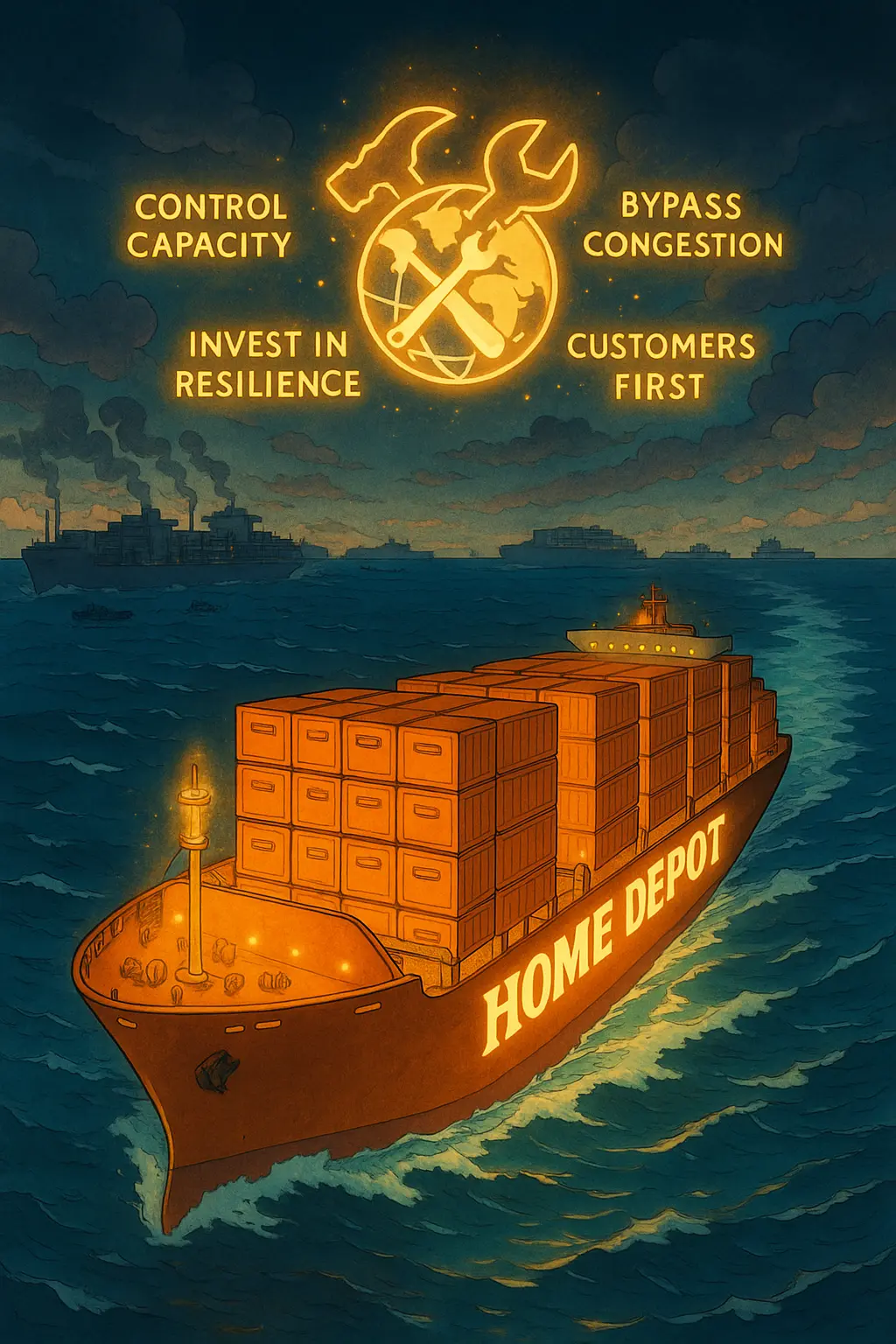
Home Depot's Container Ship
Following the pandemic, global shipping collapsed under its own weight in 2021. Demand spiked, containers were stuck in the wrong places, ports were clogged, and retailers scrambled. However, amidst the chaos, one move stood out: the Home Depot’s container ship charter.
What initially began as a joke suddenly evolved into a survival tactic, transforming how companies viewed resilience.
Key Nuggets:
- Home Depot chartered its own ship in 2021 to bypass the container shipping crisis.
- The move safeguarded seasonal inventory and kept stores stocked when competitors faltered.
- It showed that availability matters more than cost during disruptions, and other retailers, such as Walmart, Costco, and IKEA, copied the idea.
- African supply chains can benefit from diversifying their transport options, collaborating with partners, and planning for contingencies.
Background Story Behind Home Depot’s Container Ship Charter
As a result of government efforts across the globe to combat the pandemic, global trade lanes were in chaos by mid-2021. Congestion at ports like Los Angeles and Long Beach left dozens of vessels stranded offshore.
Freight rates ballooned to historic highs, empty containers sat idle in the wrong regions, and labor shortages and sudden port closures, such as China’s Yantian shutdown, further exacerbated the delays.
Home Depot’s supply chain operations were at risk. The company is one of America’s largest importers, moving more than half a million containers a year. But as a result of the delays, Power tools, plumbing supplies, heaters, and holiday goods faced delays.
For seasonal inventory, late arrival meant lost sales. As analyst Alan Murphy said, “If a big brand has 2,500 boxes sitting in Shanghai that are worth half a million dollars apiece, and it’s still there when it’s Christmas, it’s worth zero.” That hard truth made inaction impossible.
Read More: Caterpillar’s Dual Sourcing Strategy for Critical Components.
The Solution: Home Depot’s Container Ship
Due to the pandemic, demand for goods had skyrocketed, but Home Depot, along with other retailers, was struggling to keep inventory flowing. So during a planning meeting where there was no headway in solving the crisis, someone quipped, “Let’s just charter a ship.”
It was a joke, but upon further consideration, it seemed like it was the supply chain lifeline the company needed. What began as humor suddenly became the only viable solution.
By June 2021, Home Depot had secured a 700-TEU vessel dedicated solely to its goods. COO Ted Decker told CNBC, “We have a ship that’s solely going to be ours, and it’s just going to go back and forth with 100% dedicated to Home Depot.”
The company also supplemented ocean charters with air freight for certain products, which showed that no single mode was off-limits. These layered moves created buffers across modes.
Read More: Lessons From Peloton’s Excess Inventory Crisis.
The Impact of Home Depot’s Container Ship Move
The chartered vessel set sail in July, carrying containers from Chinese ports straight to U.S. docks. It gave Home Depot control over routing and allowed for strategic diversions to less congested gateways.
That control meant holiday décor arrived before December and heaters before winter peaks. Sales continued to climb for the retail giant while competitors were missing these critical items.
Home Depot demonstrated that flexibility is essential, and even a retailer can act like a carrier when conditions demand it.
Lessons From Home Depot’s Container Ship Story
Home Depot’s charter-ship experiment, and the broader 2021 shipping crisis, have yielded several important lessons for logistics and supply chain operations across the globe:
1. Agility and Bold Thinking Save Sales
Chartering a ship was unheard of for retailers. However, when traditional routes were disrupted, Home Depot’s supply chain was able to reimagine its options and proved that even in times of crisis, bold thinking can protect revenue.
2. Availability Over Cost
Freight costs for small charters went as high as $40,000 per day. Home Depot accepted that bill because empty shelves cost more than expensive freight. The companies that couldn’t afford to do that realized that protecting product flow outweighs cost control during extreme shocks.
3. Control and Visibility Reduce Uncertainty
When carriers run out of space, they typically roll cargo, which is fraught with numerous uncertainties. By running its own ship, Home Depot avoided that. It decided which ports to call and which goods to prioritize. That control gave the company predictability.
4. Scale Advantage and Collaboration
Chartering a ship is not realistic for smaller retailers. Only giants like Walmart, Costco, and Target joined the practice. But it highlights the role of collaboration. Smaller firms can partner with forwarders or pool capacity through alliances to gain similar benefits.
5. Flexibility in Ports and Modes
Home Depot combined ocean charters with air freight and alternate ports. Others, like Coca-Cola, even used bulk carriers to haul containers. The lesson is clear: resilience stems from flexibility, not from clinging to a single route or mode.
Read More: Why the 2021 McDonald’s Milkshake Shortage in the UK Happened.
How African Supply Chains Can Apply These Lessons
African supply chains face disruptions ranging from port congestion to road bottlenecks and border delays. The lessons from Home Depot’s container ship charter can be applied in the following ways:
- Think creatively: Chartering ships is not always feasible, but pooling with regional partners or utilizing alternative transport nodes can help keep goods moving.
- Balance cost with resilience: A container arriving late with critical food imports or medical supplies carries higher social and economic costs than paying extra for timely delivery.
- Strengthen partnerships: Smaller importers can align with 3PLs and shipping alliances to secure priority space.
- Diversify entry points: Instead of relying solely on Lagos or Durban, consider secondary ports when congestion is expected to peak.
- Plan for slack: Hold safety stock of essential items and secure backup routes in contracts.
Resilience for African supply chains will come from mixing creativity with long-term planning. The focus must move from the cheapest routes to the most reliable flows.

Obinabo Tochukwu Tabansi is a supply chain digital writer (Content writer & Ghostwriter) helping professionals and business owners across Africa learn from real-world supply chain wins and setbacks and apply proven strategies to their own operations. He also crafts social content for logistics and supply chain companies, turning their solutions and insights into engaging posts that drive visibility and trust.








